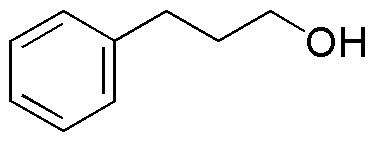3-Phenyl-1-propanol is widely utilized in research focused on:
- Fragrance and Flavor Industry: This compound is often used as a key ingredient in perfumes and flavorings due to its pleasant floral scent, enhancing the sensory experience of various products.
- Pharmaceuticals: It serves as an intermediate in the synthesis of various pharmaceutical compounds, contributing to the development of medications that require specific structural characteristics.
- Polymer Production: 3-Phenyl-1-propanol is utilized in the production of specialty polymers, offering improved properties such as flexibility and durability compared to other similar compounds.
- Research and Development: In academic and industrial labs, it is used in organic synthesis experiments, helping researchers explore new chemical reactions and pathways.
- Cosmetic Formulations: Its emollient properties make it a valuable ingredient in skincare products, providing moisture and improving the texture of creams and lotions.
General Information
Properties
Safety and Regulations
Applications
3-Phenyl-1-propanol is widely utilized in research focused on:
- Fragrance and Flavor Industry: This compound is often used as a key ingredient in perfumes and flavorings due to its pleasant floral scent, enhancing the sensory experience of various products.
- Pharmaceuticals: It serves as an intermediate in the synthesis of various pharmaceutical compounds, contributing to the development of medications that require specific structural characteristics.
- Polymer Production: 3-Phenyl-1-propanol is utilized in the production of specialty polymers, offering improved properties such as flexibility and durability compared to other similar compounds.
- Research and Development: In academic and industrial labs, it is used in organic synthesis experiments, helping researchers explore new chemical reactions and pathways.
- Cosmetic Formulations: Its emollient properties make it a valuable ingredient in skincare products, providing moisture and improving the texture of creams and lotions.
Documents
Safety Data Sheets (SDS)
The SDS provides comprehensive safety information on handling, storage, and disposal of the product.
Product Specification (PS)
The PS provides a comprehensive breakdown of the product’s properties, including chemical composition, physical state, purity, and storage requirements. It also details acceptable quality ranges and the product's intended applications.
Certificates of Analysis (COA)
Search for Certificates of Analysis (COA) by entering the products Lot Number. Lot and Batch Numbers can be found on a product’s label following the words ‘Lot’ or ‘Batch’.
*Catalog Number
*Lot Number
Certificates Of Origin (COO)
This COO confirms the country where the product was manufactured, and also details the materials and components used in it and whether it is derived from natural, synthetic, or other specific sources. This certificate may be required for customs, trade, and regulatory compliance.
*Catalog Number
*Lot Number
Safety Data Sheets (SDS)
The SDS provides comprehensive safety information on handling, storage, and disposal of the product.
DownloadProduct Specification (PS)
The PS provides a comprehensive breakdown of the product’s properties, including chemical composition, physical state, purity, and storage requirements. It also details acceptable quality ranges and the product's intended applications.
DownloadCertificates of Analysis (COA)
Search for Certificates of Analysis (COA) by entering the products Lot Number. Lot and Batch Numbers can be found on a product’s label following the words ‘Lot’ or ‘Batch’.
*Catalog Number
*Lot Number
Certificates Of Origin (COO)
This COO confirms the country where the product was manufactured, and also details the materials and components used in it and whether it is derived from natural, synthetic, or other specific sources. This certificate may be required for customs, trade, and regulatory compliance.

